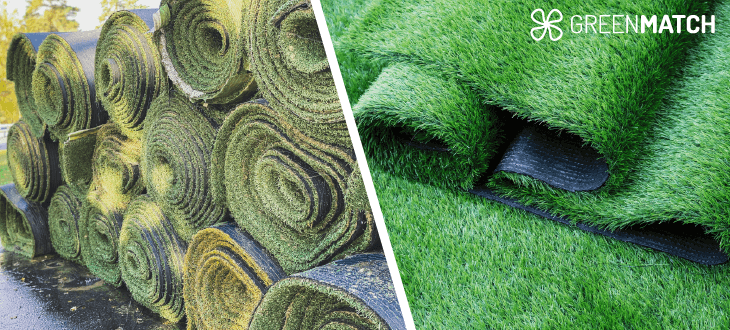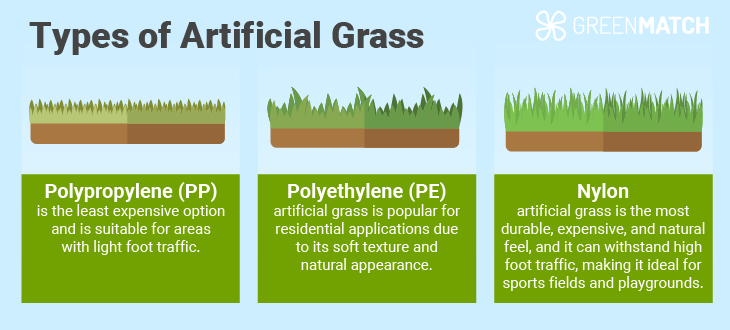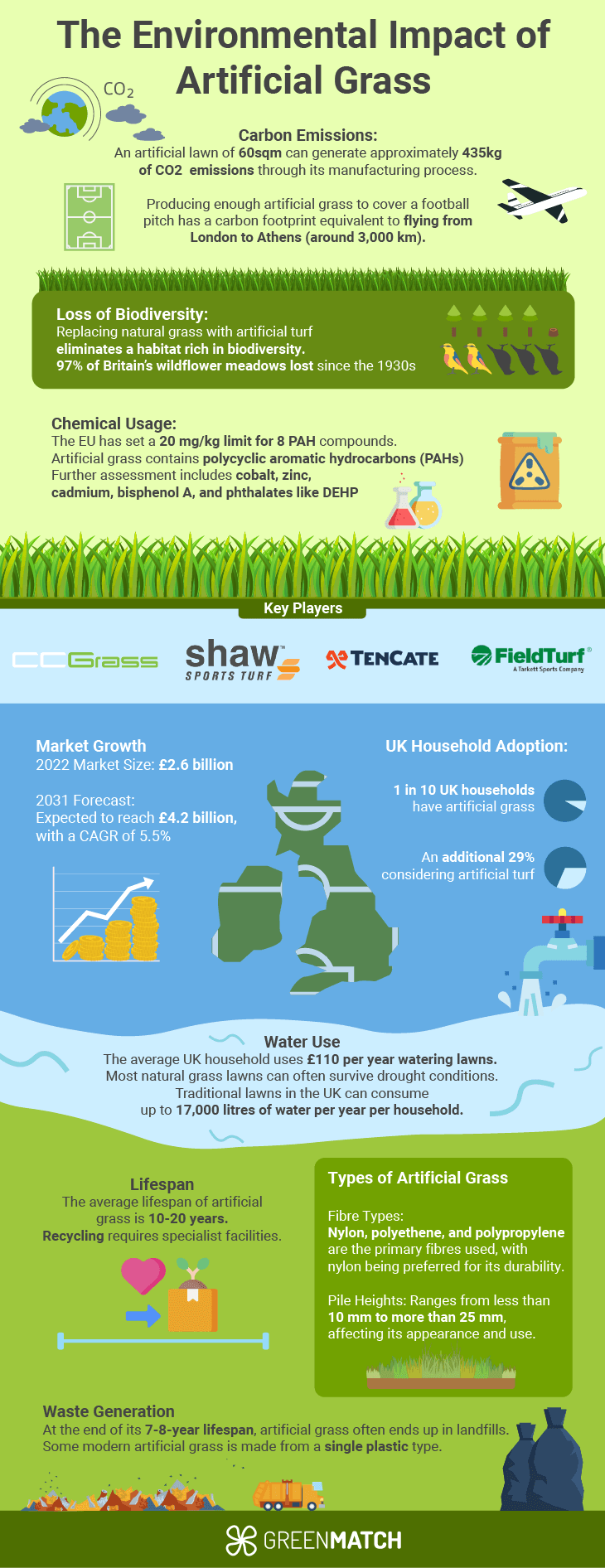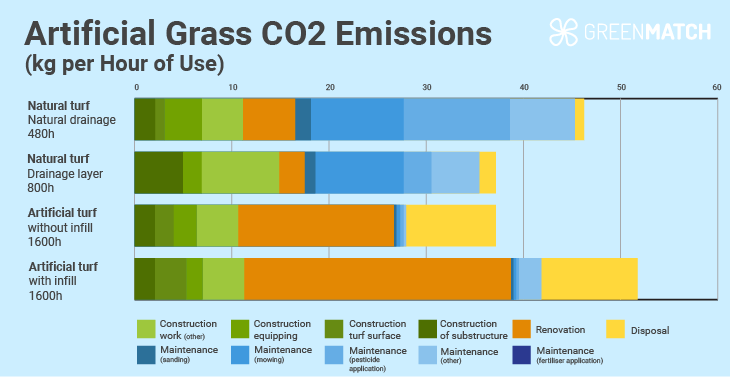- GreenMatch
- Blog
- The Environmental Impact of Artificial Grass: Insights and Trends
The Environmental Footprint of Artificial Grass: Statistics and Trends

Artificial grass, fake grass or synthetic turf has been touted as a low-maintenance alternative to natural lawns. The global market for counterfeit grass is expected to reach £4.4 billion as of 2023. However, its environmental implications raise concerns.
One of the primary benefits of artificial grass is its potential for water conservation. Traditional lawns in the UK can consume up to 17,000 litres of water per year per household. In contrast, artificial grass requires no watering, potentially saving millions of litres annually.

Manufactured from plastic and rubber materials, fake grass production is energy-intensive and relies on fossil fuels. The process emits greenhouse gases, contributing to climate change. Artificial turf is challenging to recycle once its lifespan ends, typically after 10-20 years, due to its composite materials, leading to landfill accumulation.
Homeowners love the low-maintenance appeal of fake lawns, but environmental concerns are growing.
Let's dive into the facts and shed light on the environmental implications of artificial turf by exploring various statistics and trends with expert opinions. By examining these aspects, we aim to provide a comprehensive overview empowering you to make more environmentally conscious decisions regarding your lawn care practices.
What do we mean by Fake Grass exactly?
Fake grass, artificial grass or synthetic turf has transformed from scratchy polypropylene to a softer, more visually appealing polyethylene product. This evolution has significantly increased its popularity among homeowners and commercial spaces alike.

Artificial grass consists of plastic fibres from polyethylene, polypropylene, or nylon attached to a backing material. This backing is then filled with sand or rubber to keep the blades upright and provide cushioning.
In 2020, the global market for artificial grass stood at approximately £2.4 billion, a notable rise from £2 billion in 2016, with projections suggesting it could surpass £4 billion by 2027.
Artificial grass offers a year-round green aesthetic without the maintenance required by natural lawns. High-quality artificial lawns now mimic the appearance, texture, and even the softness of natural grass. The evolution of artificial grass materials, including using recycled and plant-based components, has broadened its appeal.
This feature became particularly appealing during the pandemic as people sought to improve their home environments. However, the environmental impact of artificial grass is debated among experts and environmentalists.
Yet, as its popularity grows, so do concerns about its environmental impact.
| Aspect | Pros | Cons |
|---|---|---|
| Water Usage | Reduces water consumption for lawn maintenance | Requires water for cleaning and cooling |
| Maintenance | Low maintenance; no mowing or fertilising needed | Requires cleaning; potential for microplastic shedding |
| Temperature | Unaffected by heatwaves | Can reach high temperatures, contributing to heat islands |
| Biodiversity | It does not require pesticides or fertilisers | Lacks the ecological benefits of natural grass |
| Microplastic Pollution | Can be recycled | Contributes to microplastic pollution in waterways |

Environmental Impact of Artificial Grass
The Royal Horticultural Society (RHS) has taken a stand against artificial grass due to its negative environmental implications, banning it from events like the Chelsea Flower Show. Research highlights several concerns regarding the widespread use of synthetic turf, including its contribution to microplastic pollution and its potential to exacerbate urban heat islands.
A European Union report estimated that up to four tonnes of microplastics from artificial sports pitches across Europe end up in surface water. These microplastics threaten aquatic life and can enter the food chain, leading to broader ecological consequences. Additionally, artificial grass surfaces can reach temperatures up to 100°C, posing burn hazards and contributing to the urban heat island effect.
| Environmental Aspect | Impact |
|---|---|
| Greenhouse Gas Emissions | High due to production and disposal processes |
| Biodiversity | Negative impact on local wildlife and soil health |
| Water Runoff | Increased risk of urban flooding |
| Microplastics Pollution | Contamination of waterways and oceans |
| Urban Heat Island Effect | Elevated local temperatures |
Most artificial grass ends up in landfills after its 10-20 years lifespan, as it is difficult to separate the different recycling materials. Unlike natural grass, which helps cool the surrounding area, artificial grass absorbs and retains heat, contributing to the urban heat island effect.
This means synthetic turf absorbs and retains heat, significantly raising surface temperatures. This contributes to the urban heat island effect, exacerbating city heatwaves and requiring additional water to cool down, paradoxically increasing water usage.
| Artificial Grass Cost (GBP) | Average Overall Cost (Materials and Labour) |
|---|---|
| 300 sq. ft. | £2,730 |
| 500 sq. ft. | £4,550 |
| 800 sq. ft. | £7,280 |
| 1,000 sq. ft. | £9,100 |
| 1,500 sq. ft. | £13,650 |
What is the Impact of Artificial Grass?
Though artificial turf saves significant water, estimates suggest it can conserve between 4 to 8 billion gallons of water annually in the UK alone. Artificial grass's environmental impact spans production to disposal, with significant implications at each stage.
Here's a breakdown of its total impact:
- Total impact per year: The production of artificial grass for a single standard football field releases approximately 55.6 tonnes of CO2 from a 9,000-square-meter facility. Suppose we assume a 10-year lifespan for artificial grass installations; the CO2 emissions from a 9,000 sq.m. Considering the global market for artificial turf is set to reach £5.61 billion by 2025, the annual environmental impact is substantial. A study estimated that 1,861 trees would need to be planted to offset these emissions.
- Impact per day: Daily, the same facility contributes around 15.2 kg of CO2 emissions to the atmosphere. However, the water savings touted by artificial turf proponents are overshadowed by the adverse effects of reduced carbon sequestration and increased plastic waste.
- Impact per usage: Each artificial grass installation in a residential setting can save around 50,000 gallons of water annually. However, this benefit is offset by the loss of natural grass's ability to absorb CO2, estimated at 300 pounds of carbon per year for an average-sized lawn.
To provide a clearer picture, here's a factual data table summarising the critical environmental impacts of artificial grass:
| Impact Category | Annual Impact |
|---|---|
| CO2 Emissions (tonnes) | 55.6 per football field |
| Water Savings (gallons) | 50,000 per household |
| Carbon Absorption Loss (pounds) | 300 per average-sized lawn |
| Plastic Waste (tonnes) | Significant due to challenges in recycling |
| Garden vegetation lost in the UK (8 years) | 3,000 hectares |
Traditional Grass vs Fake Grass: Which is Better?
The environmental debate is complex. Traditional grass offers a natural habitat for wildlife and helps filter air pollution. Fake grass eliminates the need for watering and chemicals, potentially saving thousands of litres yearly. Yet, it's made from plastic, which contributes to carbon emissions during production and can harm soil biodiversity.
Fake grass, also known as artificial grass, presents a higher initial cost, averaging between £4.20 and £15.00 per square foot for installation. Traditional grass, on the other hand, costs significantly less upfront, with sod installation averaging between £0.75 and £3.00 per square foot.
Maintenance for traditional grass includes regular mowing, watering, and fertilising, which can add up to £150 to £300 annually. Artificial grass requires occasional cleaning and doesn't need water, saving homeowners on their water bills.
For instance, for a 500-square-foot area, the cost can range from £2,050 to £9,000, depending on the quality and specific product features like UV protection and blade density.
Quick Comparison: Real vs Artificial Grass
| Feature | Traditional Grass | Artificial Grass |
|---|---|---|
| Maintenance | High (£150 - £300): requires regular mowing, watering, and fertilising | Low: no mowing, less frequent cleaning |
| Water Usage | High: needs regular watering to maintain a lush appearance | Low: no watering required |
| Durability | Less durable: susceptible to weather changes and wear | More durable: withstands heavy use and diverse weather conditions |
| Environmental Impact | Positive: absorbs CO2, supports biodiversity | Negative: made from plastics, potential for microplastic shedding |
| Installation Cost (GBP) | Generally lower, but varies with lawn size | Higher: averages between £2,050 to £9,000 for 500 sq. ft. |
| Lifespan | Indefinite with proper care | 10-20 years, depending on quality and usage |
| Heat Retention | Low | High |
Here's a breakdown of the costs associated with artificial and natural grass
| Type of Grass | Initial Installation Cost (per sq. ft.) | Maintenance Cost (over 20 years) | Total Cost (over 20 years) |
|---|---|---|---|
| Artificial | £5.45 - £18.00 | £225 (cleaning and infill replacement) | £5,225 - £18,225 |
| Natural | £0.72 - £1.44 | £1,530 (watering, mowing, treatments) | £1,552 - £1,974 |
The Verdict
Both traditional and fake grass have their pros and cons. Traditional grass supports biodiversity and has a cooling effect but requires more resources and care. Artificial grass offers convenience and long-term savings but raises concerns about heat retention and environmental sustainability.
However, the shift towards artificial turf is more pronounced in regions like the Middle East and parts of the US, where water is particularly scarce.
Their choice depends on individual priorities, whether they lean towards environmental concerns, maintenance efforts, or cost-effectiveness.
The artificial grass market has witnessed substantial contributions from several key economies.
To mitigate these environmental drawbacks, companies are now exploring using renewable energy sources, such as solar panels, to manufacture artificial grass. By harnessing solar energy, these companies can reduce the carbon footprint of producing artificial turf, making it a more sustainable option in the long run.
Top Fake Grass Producing Countries
The United States, China, and countries within the European Union stand out as the primary drivers of demand and supply in this sector. The table below outlines the estimated market size and growth projections for these regions:
| Country/Region | 2022 Market Size (£) | 2031 Projected Market Size (£) | CAGR |
|---|---|---|---|
| United States | 2.4 billion | 3.9 billion | 5.5% |
| China | 2.5 billion | 4.1 billion | 5.4% |
| European Union | 2.1 billion | 3.5 billion | 4.8% |
Here, we explore the leading countries that produce artificial grass and its environmental impact.
Leading Producers of Artificial Grass
- China: Dominates the global market in artificial grass production. Known for its large-scale manufacturing capabilities, China produces a wide range of artificial grass products catering to budget and premium segments.
- United States: Home to major brands like Shaw Sports Turf and FieldTurf, the U.S. focuses on innovative artificial turf solutions, particularly for sports and landscaping applications.
- Netherlands: A key player in Europe, known for its high-quality artificial grass products. Dutch companies like Ten Cate and Edel Grass are renowned for their durable and aesthetically pleasing turf solutions.
- United Kingdom: Although smaller than the producers mentioned above, the UK has a growing artificial grass industry focusing on sustainable and eco-friendly products.
Top Artificial Grass Producers and Their Market Share
| Country | Leading Companies | Market Share (%) | Notable Products |
|---|---|---|---|
| China | CCGrass, Taishan, ForestGrass | 35 | Sports and landscaping turf |
| United States | Shaw Sports Turf, FieldTurf | 25 | Premium sports turf |
| Netherlands | Ten Cate, Edel Grass, Landscape Solutions | 20 | Eco-friendly turf |
| United Kingdom | Trulawn, NeoGrass | 10 | Sustainable residential turf |
While the economic benefits of artificial grass are clear, its environmental impact raises concerns. Artificial turf production involves significant energy consumption and toxic chemicals, contributing to carbon emissions and potential health risks.
However, it is interesting that some countries have taken proactive steps to address this issue with artificial grass. For example, the Netherlands has proactively announced plans to phase out artificial grass in sports fields by 2030, citing health and environmental concerns.
This decision underscores the growing awareness and action against the potential negative impacts of artificial grass.
Is Fake Grass Toxic?
The answer is more than a simple yes or no. While high-quality turf uses materials similar to common household plastics, some lower-grade options may contain lead or unhealthy levels of other toxins.
Recent studies have raised concerns about the chemicals present in artificial grass. Beyond Plastics highlights that synthetic turf fields contain hazardous chemicals, posing risks to human health. The National Toxicology Program found that crumb rubber in artificial grass contains harmful substances like phthalates and bisphenol-A (BPA). These findings have sparked a global conversation on the safety of artificial turf.
Health risks associated with artificial grass primarily stem from its composition. Safe Healthy Playing Fields Inc. reveals synthetic turf contains lead, mercury, cadmium, and other carcinogens. Children and athletes, in particular, face exposure risks through skin contact or inhalation of toxic particles.
Some have pointed out that modern artificial turf may contain PFAS, a class of "forever chemicals" linked to various health problems. While research is ongoing, the presence of PFAS raises concerns about potential health risks.
Despite these concerns, the artificial grass market continues to grow, with a projected upward trend through 2030.
Is Artificial Grass Biodegradable?
Are you thinking about fake grass for your garden? While it eliminates mowing, consider this - traditional artificial grass is not biodegradable.
Made from plastic materials like nylon and polypropylene, artificial turf takes centuries to decompose in landfills. Research suggests a lifespan of 20 to 500 years, leaving a lasting environmental footprint. This longevity contributes to landfill waste and can lead to microplastic pollution as the material breaks down under environmental stressors like UV radiation and physical wear.
Can Fake Grass be Sustainable?
One of the main selling points for artificial grass is its ability to conserve water. In regions like California, where water scarcity is a pressing issue, replacing natural lawns with synthetic alternatives can significantly reduce water usage. It can significantly reduce water usage compared to natural grass, which can gulp between 500,000 to 1 million gallons annually.
However, artificial grass does not support biodiversity in the same way that natural grass does. Natural lawns provide a habitat for various microorganisms, insects, and other wildlife and play a role in carbon sequestration.
Sustainability concerns linger, particularly regarding microplastics. Artificial turf can shed plastic fibres, contributing to microplastic pollution, a severe environmental issue, as these particles can end up in waterways.
Moreover, companies are exploring recyclable materials and alternative infills, like ocean plastic, to create more sustainable turf options.
Can Fake Grass Be Recycled?
Recycling fake grass is challenging and often only possible sometimes. This means old turf is in landfills, adding to the growing plastic waste problem.
While manufacturers often claim a lifespan of 10 to 20 years, the reality can be different due to wear and tear, especially in high-traffic areas.
Several initiatives are making strides in artificial grass recycling. Companies like TenCate Grass have developed programs to recycle old turf into new products, such as padding for sports fields or other synthetic surfaces. In Europe, GBN Artificial Grass Recycling (GBN-AGR) has set up facilities to process end-of-life synthetic turf into new, circular raw materials.
For instance, Re-Match in Denmark has developed a technology that separates and cleans artificial turf, allowing nearly 99.9% of the material to be reused. Similarly, new products like the Green Recyclable Series from CCGrass are designed to be 100% recyclable through normal recycling facilities, addressing the end-of-life disposal issues traditionally associated with artificial grass.
Environmental Impact Compared to Everyday Things
How about ditching the lawnmower and installing artificial grass? While it boasts perks like reduced water use and no mowing, let's compare artificial grass CO2 emissions to everyday items.
The production of enough artificial grass to cover an average garden can emit over 1,000 kg of CO2, equivalent to driving a car for approximately 2,480 miles
Artificial Grass vs. Everyday Items: CO2 Smackdown
| Item | Lifetime CO2 Emissions (kg) |
|---|---|
| Artificial Grass (per square metre) | 36 |
| Smartphone (including production & disposal) | 70 |
| One Transatlantic Flight | 8,000 |
| Annual household electricity (UK average) | 2,700 |
| New Gas Boiler Installation | 2,400 |
While artificial grass has a lower CO2 footprint than a transatlantic flight, it's not all sunshine and rainbows. For instance, installing 100 sqm of artificial grass equates to the CO2 emissions from 600 km of car travel. Moreover, manufacturing artificial grass involves the use of fossil fuels.

What Are Alternatives to Fake Grass: Artificial Grass
When considering alternatives to artificial grass, various options are available that can reduce maintenance needs and enhance environmental sustainability.
Here, we explore viable alternatives that enhance aesthetic appeal and provide ecological benefits.
Alternatives to Artificial Grass
- Native Plants and Wildflowers: Opting for native plants or creating a wildflower meadow instead of artificial turf supports local biodiversity and requires minimal upkeep once established.
- Clover Lawns: Clover is low-maintenance, naturally fertilises the soil by fixing nitrogen, and stays green without needing much water.
- Mulch or Gravel: Using mulch or gravel can cover ground effectively, suppress weeds, and reduce water usage. These materials also offer a porous surface that prevents water runoff.
- Wood Chips or Bark: These natural materials provide a rustic look and enrich the soil as it decomposes, improving soil health over time.
- Moss Gardens: Ideal for shady or damp areas, moss gardens create a lush green carpet that requires no mowing and minimal watering.
- Hardscaping: Incorporating stone, pavers, or decking can reduce lawn space while adding structure and utility to garden areas.
- Xeriscaping: This approach utilises drought-tolerant plants, rocks, and mulch to create a low-water, low-maintenance outdoor space.
Is It Better Than Alternatives?
When comparing artificial grass to its alternatives, it's clear that other options often surpass artificial turf in terms of environmental benefits, maintenance, and cost-effectiveness. For instance, natural plantings like meadows and Xeriscaping promote biodiversity and reduce water usage, making them more eco-friendly than synthetic ones.
Moreover, the high upfront cost of artificial turf, ranging from £6,250 to £12,500 for installation, makes natural alternatives more appealing for budget-conscious homeowners.
In contrast, natural alternatives like native plants and mulch improve soil health, support local wildlife, and reduce carbon footprints.
| Material | Lifespan (years) | Maintenance Required | Environmental Impact |
|---|---|---|---|
| Artificial Grass | 10-20 | Low | High |
| Native Plants | Indefinite | Moderate | Low |
| Clover Lawns | Indefinite | Low | Low |
| Mulch/Gravel | Indefinite | Low | Moderate |
| Wood Chips/Bark | 1-4 | Moderate | Low |
| Moss Gardens | Indefinite | Low | Low |
| Hardscaping | Indefinite | Low | Variable |
Statistics, Facts and Figures About Artificial Grass
The global landscape is changing, and artificial grass is at the forefront of this transformation. Here, we delve into fake grass's compelling figures and environmental impacts, offering a worldwide perspective crucial for understanding this modern trend. Sourced from different environmental studies
Global Market Overview and Segmentation
- The market is projected to grow at a healthy 6.5% annually until 2028.
- The global market reached approximately £58 billion in 2022 and is projected to grow to £87 billion by 2028.
- The artificial grass market in South America has grown at a CAGR of 9.82% since 2018.
- Europe is a significant market, with a projected compound annual growth rate (CAGR) of around 7%.
- North America held the largest market share since 2018, with a value of around £870 million, driven by factors such as advanced infrastructure and a strong business environment.
- Regarding product types, turf grass with a pile height between 10 and 25 mm is expected to witness significant demand.
Environmental Impact
- A typical 60sqm artificial lawn can generate approximately 435kg of CO2e from manufacturing.
- The production of artificial turf involves significant carbon emissions.
- According to a study, only 8% of the environmental impact of artificial turf comes from maintenance, while renovation and disposal account for 45-48% and 20-23% of greenhouse gas emissions, respectively.
- Cleaning artificial grass often requires harsh chemicals to remove contaminants like sweat and bird droppings, which can pollute local waterways.
Usage Statistics by Region
- North America:
- Dominates the market with a value of £0.85 billion in 2018, reflecting high demand in sports facilities and residential landscaping.
- North America is just a little behind, with the Synthetic Turf Council reporting that over 12,000 synthetic turf sports fields are in use.
- Production is increasing by 20% every year.
- Europe:
- The market here is growing steadily, with a revenue of £650 million and a projected CAGR of 4% through 2029.
- Europe leads in adopting artificial grass, with the UK market burgeoning as homeowners and businesses seek convenience.
- The European Synthetic Turf Organization estimates that the continent manufactures over 37 million square meters annually.
- The use of artificial grass in Europe is encouraged by its application in sports and public areas.
- Artificial grass can absorb heat, raising local temperatures and contributing to urban heat islands.
- Asia-Pacific:
- This region is experiencing the fastest growth in the artificial turf market, with a CAGR of 7.1% expected from 2023 to 2028.
- China emerges as a significant producer, supplying approximately 70% of global synthetic turf fibres.
- Middle East and Africa:
- The market in this region is set to expand at an impressive CAGR of 18.4%, reaching £1.45 billion by 2030.
- Growing high maintenance cost of natural grass in arid regions
Key Players and Innovations
- FieldTurf (Tarkett), Victoria PLC, and TenCate Grass are major manufacturers.
- Innovations such as the V-Shape®, MiNT®, and ReaDY® technologies by Royal Grass enhance the realism and durability of the turf through advanced yarn tech.
FAQ- Fake Grass
There are environmentally friendly options for artificial grass. These products are made from non-toxic, renewable materials like sugar cane and have a backing made from plant-based oils such as soybean oil. However, while these options are better, they still have environmental impacts during production and disposal.
Consider using fake grass due to its environmental drawbacks. Artificial turf can contribute to heat absorption, leading to higher temperatures in your garden. It also lacks biodiversity, preventing soil and critters beneath from thriving. Moreover, producing and disposing of artificial grass involves non-renewable resources and can result in landfill waste.
Yes, artificial turf is harmful to the environment. It is primarily made from plastic materials derived from fossil fuels. The production process releases carbon emissions, and the end product is non-biodegradable, contributing to long-term environmental pollution. Additionally, the breakdown of artificial turf can release microplastics and other pollutants into the environment.
The disadvantages of artificial grass include:
- High initial installation cost.
- Potential for heat absorption, making it uncomfortable in hot weather.
- Limited lifespan, with most products lasting 10-20 years before needing replacement.
- Difficulty in recycling, leading to environmental concerns

Inemesit is a seasoned content writer with 9 years of experience in B2B and B2C. Her expertise in sustainability and green technologies guides readers towards eco-friendly choices, significantly contributing to the field of renewable energy and environmental sustainability.
We strive to connect our customers with the right product and supplier. Would you like to be part of GreenMatch?

